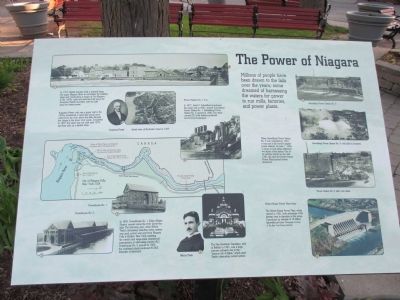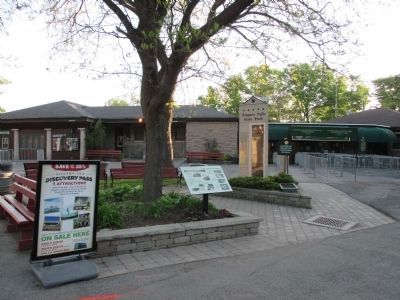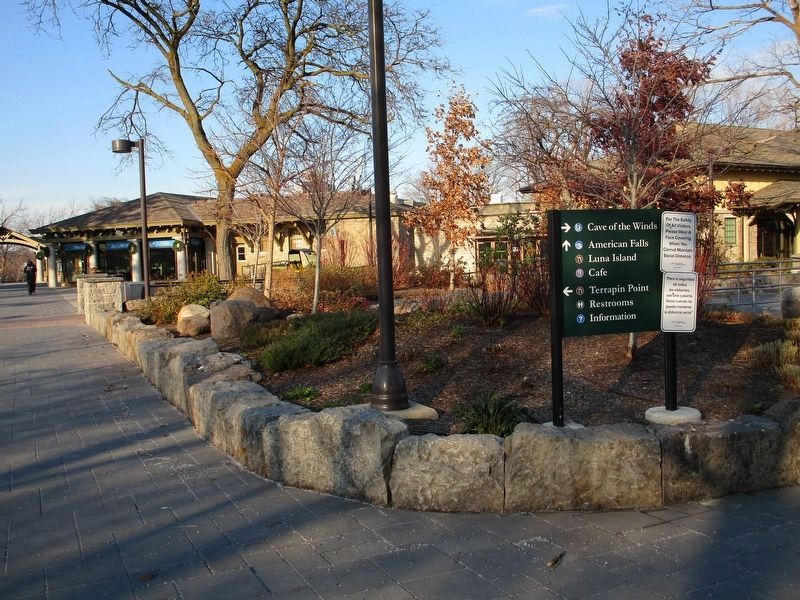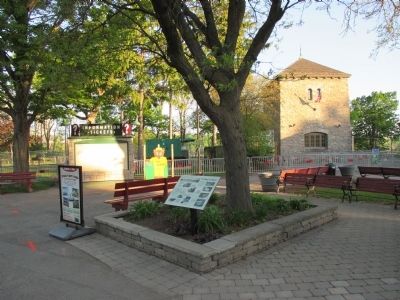Niagara Falls in Niagara County, New York — The American Northeast (Mid-Atlantic)
The Power of Niagara
Millions of people have been drawn to the falls over the years; some dreamed of harnessing the waters for power to run mills, factories, and power plants.
In 1757, Daniel Joncaire built a sawmill along the upper Niagara River to cut lumber for building ships and constructing a chapel at Fort Niagara. In the 1800s, mills and factories built along the American Rapids shoreline used an inlet canal for water power.
Augustus Porter, who ran a paper mill in the 1820s, envisioned a canal that would carry water from the river above the falls, through the village to the lower river gorge. Completed in 1857, the canal was not used until 1875, and then only on a limited basis.
Power Statons No. 1 & 2. In 1877, Jacob F. Schoellkopf purchased the canal, and in 1881, opened Schoellkopf Power Station No. 1. Schoellkopf Power Station No. 2 opened in 1896. The direct current (DC) both stations produced served local businesses.
In 1895, Powerhouse No. 1 (Dean Adams Station) opened along the river above the falls. The following year, when Nikola Tesla's alternating induction motor system was used, power was sent from Niagara Falls to Buffalo, New York, marking the world's first large-scale commercial transmission of alternating current (AC). Powerhouse No. 2 opened in 1905; the combined plants produced 80,000 kilowatts of electricity.
The Pan-American Exposition, held in Buffalo in 1901, was a huge success primarily due to the "famous city of lights," which used Tesla's alternating current system.
When Schoellkopf Power Station No. 3 was completed in 1924, it was one of the world's largest power stations. On June 7, 1956, a series of rock slides destroyed two-thirds of the station. One of its sections stayed on line until 1961, the year the Robert Moses Power Plant opened further downriver.
Robert Moses Power Plant today. The Robert Moses Power Plant, which opened in 1961, took advantage of the greater drop in elevation in the gorge; it produces an average of 13 billion kilowatts per hour. Photograph courtesy of The New York Power Authority.
Topics. This historical marker is listed in this topic list: Industry & Commerce. A significant historical year for this entry is 1757.
Location. Marker is missing. It was located near 43° 4.93′ N, 79° 4.271′ W. Marker was in Niagara Falls, New York, in Niagara County. Marker could be reached from Goat Island Road. Marker was located in front of where the Cave of the Winds Ticket Windows were, on Goat Island, which is part of Niagara Falls State Park. Touch for map. Marker was in this post office area: Niagara Falls NY 14303, United States of America. Touch for directions.
Other nearby markers. At least 8 other markers are within walking distance
of this location. Original Stepping Stone (a few steps from this marker); Cave of the Winds Elevator (within shouting distance of this marker); World's First Hydroelectric Power Plant (within shouting distance of this marker); The Power Portal (within shouting distance of this marker); Nikola Tesla (about 300 feet away, measured in a direct line); a different marker also named Nikola Tesla (about 300 feet away); Niagara River Corridor Important Bird Area (about 300 feet away); The Cave of the Winds (about 400 feet away). Touch for a list and map of all markers in Niagara Falls.
Also see . . .
1. Nikola Tesla. Wikipedia entry (Submitted on June 10, 2014, by Anton Schwarzmueller of Wilson, New York.)
2. Schoellkopf Power Station Disaster. Niagara Frontier website entry (Submitted on June 10, 2014, by Anton Schwarzmueller of Wilson, New York.)
3. Robert Moses Niagara Power Plant. Wikipedia entry (Submitted on June 10, 2014, by Anton Schwarzmueller of Wilson, New York.)
4. Niagara Power Vista Visitors Center. New York Power Authority website entry (Submitted on June 10, 2014, by Anton Schwarzmueller of Wilson, New York.)
Additional keywords. electric, electricity
Credits. This page was last revised on January 5, 2022. It was originally submitted on June 10, 2014, by Anton Schwarzmueller of Wilson, New York. This page has been viewed 469 times since then and 14 times this year. Photos: 1, 2. submitted on June 10, 2014, by Anton Schwarzmueller of Wilson, New York. 3. submitted on November 20, 2020, by Anton Schwarzmueller of Wilson, New York. 4. submitted on June 10, 2014, by Anton Schwarzmueller of Wilson, New York. • Bill Pfingsten was the editor who published this page.



